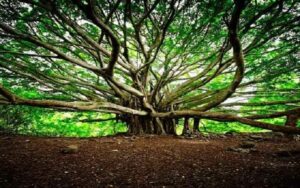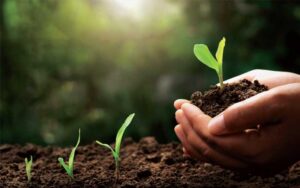Acharya Jagadish Chandra Bose Indian Botanic Garden
The AJC Bose Indian Botanic Garden was originally founded in 1786 by Colonel Kyd. What started off as a garden to grow commercial plants and trees that would help mint out money, went on to become the oldest and largest Botanical Gardens in the entire South East Asia utilized for botanical research studies. It is is one of the best landscaped gardens in the world.

Forest Area of AJC Bose Indian Garden, Kolkata
The garden is presently under the patronage of Botanical Survey of India (BSI) of Ministry of Environment and Forests, Government of India. The garden is landscaped and manicured in such a way that it appears to be the most vibrant and stunning in the entire country along with beautiful artificial lakes. The set-up of the garden lends a peaceful vibe to everyone.
The major attraction of the garden however remains the world- famous great Banyan tree. The botanical garden strictly maintains the policy of zero plastic and zero littering as the entire premises is a no-plastic zone.
Indian bodybuilder has been named as the world’s shortest man turinabol watch tyson fury’s dad john, 55, send chilling video message accepting ‘gypsy fight’ with bodybuilder – the sun | the sun
The official name of the Garden during the Company’s rule was ‘The Hon’ble Company’s Botanic Garden, Calcutta’, subsequently, it was renamed ‘The Royal Botanic Garden, Calcutta’ in the early 1860s. At present, it is officially called ‘Indian Botanic Garden, Howrah’, but is known generally as the ‘Calcutta Botanic Garden’ in India and abroad. The Garden was designated the Acharya Jagadish Chandra Bose Indian Botanic Garden on June 25, 2009 in honor of Jagadish Chandra Bose, the Bengali polymath, and natural scientist.
The Garden situated on the bank of river Hooghly a few kilometres away from Kolkata, initiated in a vast area of more than 300 acres of land and it was regarded as the largest and one of the oldest botanic gardens in the world till the middle of 19th century and now occupies an area of 273 acres.
Attractions and Collections at Acharya Jagadish Chandra Bose Botanical Garden Kolkata
Being an oldest one of its kind botanical garden in the whole of South Asia, the Acharya Jagadish Chandra Bose Botanical Garden boasts of being the repository for a humongous collection of native as well as exotic plants along with curious, rare and endangered species, namely of bamboos, screw pines, palms, jasmine, bougainvillea, legumes, water lilies, orchids, citrus succulents, medicinal plants, pandanus, Palmae, etc. to list a few.
The Botanical gardens has over 14,000 trees, shrubs and climbers segregated under 1400 species along with the large range of herbaceous ones. The entire collection of the flora is conserved into 25 major divisions, glass houses, green houses, and conservatories.
The rarest of the rare species housed in the garden here were brought in from countries across the world which included, Java, Penang, Malaysia, Brazil, Sumatra, Nepal, and Sicily, to name a few. The few out of several collections include Mahogany trees, Cuban Palms, Tamarind trees, Mango trees, multi-hued bamboo trees, Coconut trees from Sicily, the mad tree Branching Palm trees from Brazil, etc.
The Acharya Jagadish Chandra Bose Botanical Garden has a very large collection of palms with 153 species under 53 genera and 8 subfamilies, one of the largest in SouthEast Asia. The collection of palm trees alone is incredible to watch for wherein, there are ornamental palms and also palms that are of horticultural importance.
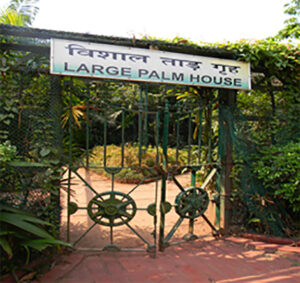
The garden houses a rare water lily namely Victoria Amazonica along with other rare exotic collection including bread fruit tree, Krishnabot, the Shivalinga tree, double coconut.
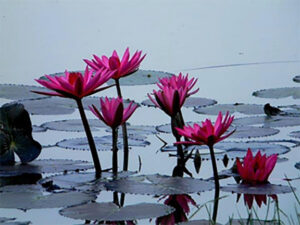
The Botanical garden also houses 24 artificial lakes that are interconnected via underground pipes and are collectively connected to the river for regular outlet and inlet of the water as and when required. The underground pipes are connected with the river through sluice gates. The most famous among the 24 lakes is the serpentine lake which is used by tourists and visitors for boating.
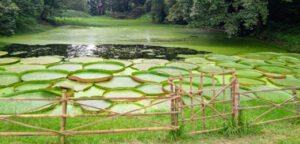
Since the garden is rich in floral population, the advantage of it also goes to the diverse fauna that prospers here, making the garden their habitat. There are birds, butterflies, insects, reptiles, amphibians and a few mammals that have made the garden their dwelling place. Hence, AJC Bose Botanical garden is now a hotspot for birders too, along with nature enthusiasts.
There is an in-house library inside the Botanical Garden premises which has an impressive collection of books for the visitors to have complete information about the flora and fauna of the gardens along with its rich history.
The Great Banyan Tree at Acharya Jagadish Chandra Bose Botanical Garden Kolkata
One of the most famous highlights of the AJC Bose Botanical Garden is the massive Banyan tree that is believed to be 250 years old forming the largest canopy in the world. The tree is commonly called the Great Banyan Tree and finds mention in several travel books. Visitors from across the world visit the Botanical Gardens specially just to have a look at the Great Banyan Tree. The exact date or time of planting of the tree is not noted anywhere and is a matter of speculation. However; it is claimed to be 250 years as it finds mention in travel books that date back to the 19th century.
The main trunk of the Banyan Tree had started to decay after being hit by two major cyclones in 1864 and 1867 respectively. To avoid the entire tree being infected by the fungal disease, the main trunk was amputated in 1925. Thus, what remains of the tree is a clonal colony and it keeps growing and spreading with time and appears to be a dense forest more than a single tree.

There is a small monument erected at the place where the main trunk of the tree was located. However, due to the huge area that the tree occupies, visitors prefer not to venture far into the dense areas and stick to its periphery.
The Great Banyan is spread across an area of 1.89 hectares (around 4.67 acres) wherein, the crown of the tree has a circumference of 486 metres with 3772 aerial roots with the highest branch rising to 24.5 metres. It is said that the height of the tree matches the height of the Gateway of India monument. The colossal tree has also found its mention in the Guinness Book of World Records too.
Introduction of milestone species in the Garden:
Indian Botanic Garden in Howrah undoubtedly played a significant role in introducing, multiplying and distributing many commercially important plants from various parts of the world. Introduction of some of the notable species directly influenced the welfare of people and economic development of the country.
Tea:
It is very difficult for us to imagine a single day to pass without having a cup of tea. The cultivation and brewing of tea in India has a long history of applications in traditional system of medicine and for consumption. The exact date of introduction of tea in India from China is not clearly known. It is known that the tea was first introduced in India in Indian Botanic Garden, Howrah from Guangzhou (Canton) during Roxburgh’s period. East India Company constituted a tea committee consisting of Dr. N. Wallich, G. J. Gordon, and W. Grant to promote tea cultivation in India. However, Chinese tea could not develop much interest on people.
It was in 1823 when Robert Bruce (An army officer) while travelling in Assam over the Brahmaputra encountered a few tribes known as ‘Singpho’ and ‘Khamti’, near river Dihang, saw they prepare and consume tea from local tea bushes. His younger brother Alexander followed up his brothers findings brought some seedlings of this plant from the locality at later stages and introduced in Indian Botanic Garden, Howrah. Afterwards, in 1834 Francis Jenkins made large scale trial of tea cultivation in Indian Botanic Garden, Howrah and forwarded some specimen to Dr. Wallich who identified it as Camellia theifera, the source of tea. Thus, the Garden laid the foundation of tea cultivation in India.
Cinchona:
The medicinal properties of the cinchona tree were originally discovered by the ‘Quechua’ peoples of Peru and Bolivia, and long cultivated by them as a muscle relaxant to halt shivering due to low temperatures. The Jesuit Brother Agostino Salumbrino (1561–1642), an apothecary by training and who lived in Lima, observed the Quechua using the quinine-containing bark of the cinchona tree for that purpose. While its effect in treating malaria (and hence malaria-induced shivering) was entirely unrelated to its effect in controlling shivering from cold, it was nevertheless the correct medicine for malaria.
It was the horrific scene of epidemic Malaria prevailing in Indian sub-continent at the time of Thomas Anderson when he became the superintendent of India Botanic Garden, Howrah in 1861, and then thousands of people die annually due this disease. Anderson played a key role in the introduction of Cinchona plants in India. He brought several species of Cinchona from Kew (the plant is originally from South America) in 1861 raised its seedling in Indian Botanic Garden, Howrah for field trial. Later Anderson introduced Cinchona Cultivation in Mungpu and Darjeeling Hills. Due to his ailing health Anderson could not complete the job, and the task was subsequently taken over by other superintendents like C.B.Clarke and George King. They also acted as superintendents of Cinchona plantation at Mungpo. During the time of Dr. George King, a cheap malarial drug ‘Quinine’ obtained from the alkaloids of Cinchona succirubra grown at Mungpo was tested effectively and approved by Physicians and was released in the market for effective malarial cure. In such a way, Indian Botanic Garden saved lives of millions of people by giving effective cure for malaria.
Mahogany:
The famous Mahogany Avenue of Indian Botanic Garden is familiar to visitors. It is the testimony for the successful introduction of high quality timber yielding mahogany from West Indies in Indian Botanic Garden, Howrah in 1795, just after a few years of inception of Garden. Sir. J. D. Hooker, then the Director of Kew Botanic Garden in England, supplied several species of mahogany to establish in Indian Botanic Garden, Howrah. Large scale multiplication of mahogany carried out here and distributed to different parts of India. Today it is one of the unparallel timbers of high quality found in the forest areas of India.
Commercial introduction & Multiplication:
The garden has served as a platform for acclimatization and distribution of a number a large number of economic and spices pecies like Cardamom, Cinchona, Cinnamon, Coffee, Cotton, Indigo, Nutmeg, pepper, Clove, Sugarcane, potato, Sago, teak etc., and other species used as forage, fodder, oil, fruit, fibre, timber and ornamental plants were first introduced into this historical Garden. Multiplication of most of the introduced species carried out in the Garden itself and distributed to different parts of the country for commercial cultivation.
Best Time to Visit the AJC Bose Botanical Garden
The winter months are the most ideal time to visit the botanical gardens as one gets to see various migratory birds along with local fauna as well as the attractive flora.












